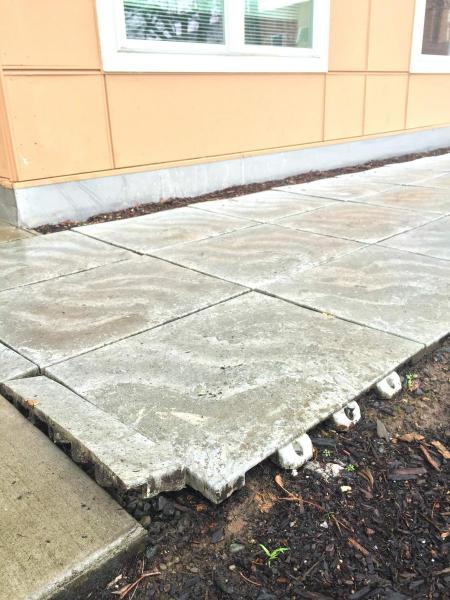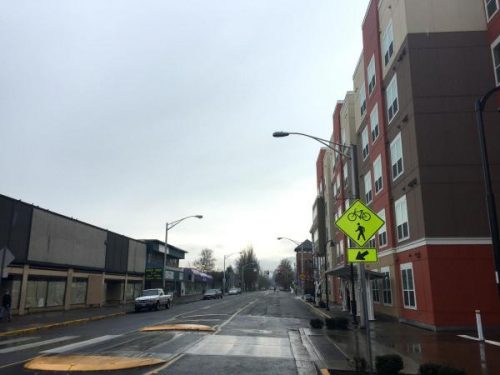
An urban promenade, balconies, sloped roofs, trellises, tables and chairs on the street.
Those features were all promised in Capstone Collegiate Communities’ application for a Multi-Unit Property Tax Exemption (MUPTE) submitted to the city of Eugene on Jan. 24, 2012. City Manager Jon Ruiz recommended the application to the City Council, which voted to approve Capstone for the exemption, allowing developers to pay no taxes on the new structure for 10 years — or the equivalent of a $16-million tax break.
The application also stated there would be a 5,000-square-foot retail space on the ground floor that would be “synergistic with the residents and will enable convenience food or service options on site and create additional retail and pedestrian activity along Willamette Street.”
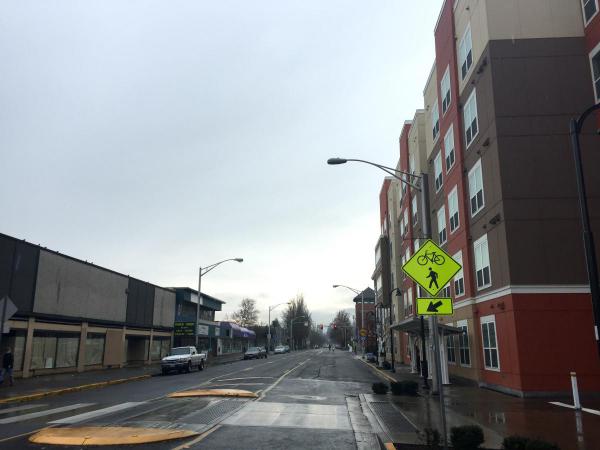
Today, walk by the enormous student-housing complex, 13th & Olive, and it is immediately clear that none of those promises were kept. Eugene is not known for a particularly attractive urban landscape, but the site, deemed “Crapstone” by many, is particularly bleak. It has no balconies, no sloped roofs, no street furniture, no retail spaces, no vibrant street life. Some of the sidewalks, especially along high-traffic 13th Avenue, feel downright dangerous to walk along.
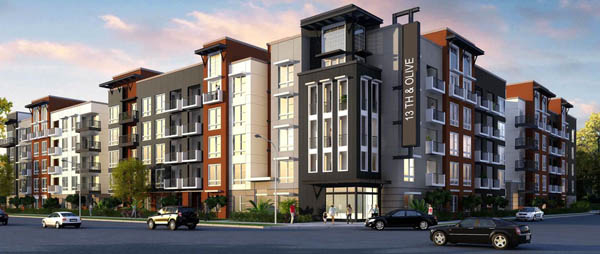
So what happened?
“We did not lock in the design of the building,” Senior City Planner Nan Laurence told EW in November. “We didn’t know that what [Capstone] proposed would be so different from what they built.”
Laurence continued: “There was no one in the city who was watching over [what] the illustrative image on the building permit set and then what was actually built.”
To put it plainly: No one on the city of Eugene’s staff was tasked to enforce the building designs of an out-of-state developer receiving a $16-million tax break for a $90-million housing project.
The Capstone snafu, in part, prompted the city of Eugene to suspend the MUPTE program in 2013, a program dating back to the ’70s designed to incentivize development and population density in the urban core.
On July 13, 2015, the Eugene City Council voted to reinstate MUPTE through Ordinance 20556, which made amendments to the original code including stricter design enforcement and making student housing projects ineligible.
MUPTE became a hot topic again in the fall of 2015 when a local development group — Rowell Brokaw Architects, downtown business owner Kazem Oveissi, developer consultant Mark Miksis and advising developers Hugh Prichard and Harris Hoffman — submitted a proposal to the city to purchase Kesey Square, a public land parcel, and in its place build an apartment building with retail on the ground floor. The developers have said they will ask for a 10-year MUPTE for the project, as well as a loan from the city.
The city already approved a MUPTE in 2012 for Rowell Brokaw Architects and Oveissi’s “First On Broadway” project, also an apartment building with ground-floor retail space. They are building a similar project in the parking lot across the street from Kesey Square between Toadstool Cupcakes and the Wells Fargo building this spring.
“I think we’ve all learned something as a result of Capstone,” City Manager Jon Ruiz told EW in November. “In part because of the Capstone project, we have revamped the MUPTE program pretty significantly.” Ruiz said there will be more accountability and oversight.
The new MUPTE requires the city manager and a 10-person review panel to oversee any future MUPTE projects, from design submission to completion of construction.
“Failure to comply with the approved design (and any other MUTPE program requirements or any of the individual project approval resolution) may result in an administrative civil penalty [E.C. 2.947(8)] or in termination of the tax exemption [E.C. 2.947(1) – (7)],” wrote Amanda Nobel Flannery, Eugene’s economic prosperity programs manager, in an email to EW.
Additionally, Flannery told EW, “the final design is submitted to staff before it is submitted for permits, staff will review conformance with the design that is attached to the approval resolution.”
The new MUPTE ordinance, however, does not require retail space on the ground floor, considered an essential component in city planning and place-making to create a vibrant and safe pedestrian experience. In the city’s own Community Design Handbook, it states: “Maximize pedestrian activity on the street with retail frontage along the sidewalk and living spaces at street level.”
While Ruiz and Laurence acknowledged issues with Capstone’s 13th & Olive student housing complex, they said it was a “net gain” for the city, acquiring the urban density desired. They also argued that it was not the eyesore many in the community have expressed it to be.
Laurence told EW that when renowned urban designer and author of Walkable Cities Jeff Speck came to Eugene in June 2015 to give a talk, she took him to 13th & Olive.
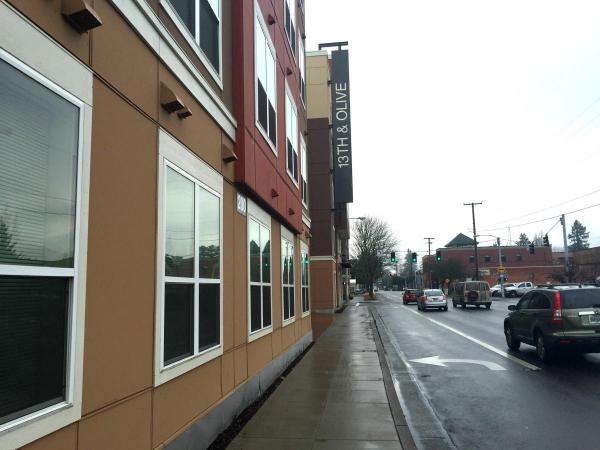
“We took him there and we said, ‘What can we do to fix this?’” Laurence recalled. “He wasn’t troubled by it. He’s like, ‘I don’t see the problem.’”
EW followed up with Speck via email who clarified that he “had no problem with the urbanism of the project, but was troubled by the architecture.”
Speck continued: “The architecture suffers principally from three problems. First, [which is] easy to code against, is the common error that these huge buildings have been conceived as a single design. The monotony of having the same facade for so many yards along one street — on both sides, no less — could have been prevented by a regulation requiring mega-buildings to appear to be multiple buildings of different design. The city should enact such a regulation.”
He went on to say the building should have been required to have more variety in its exterior design rather than “one big mishmash that shows no architectural objective beyond the desire to disappear.”
Speck said the building is “wafer thin, of incredibly shallow, cheap construction,” concluding that “this sort of parsimony is much harder to code against: The most effective preventative measure is public shaming.”
Laurence said the city is still in “conversations with Capstone to see what could make it better.” She added that every new project is an opportunity to improve, especially with the added incentive of the 2021 International Association of Athletics Federations World Championships coming to Eugene.
“By 2021, when the eyes of the world are on us and people are here from 180 countries, I want [Willamette Street] to look like it’s our main street and it’s dressed up,” Laurence added.
